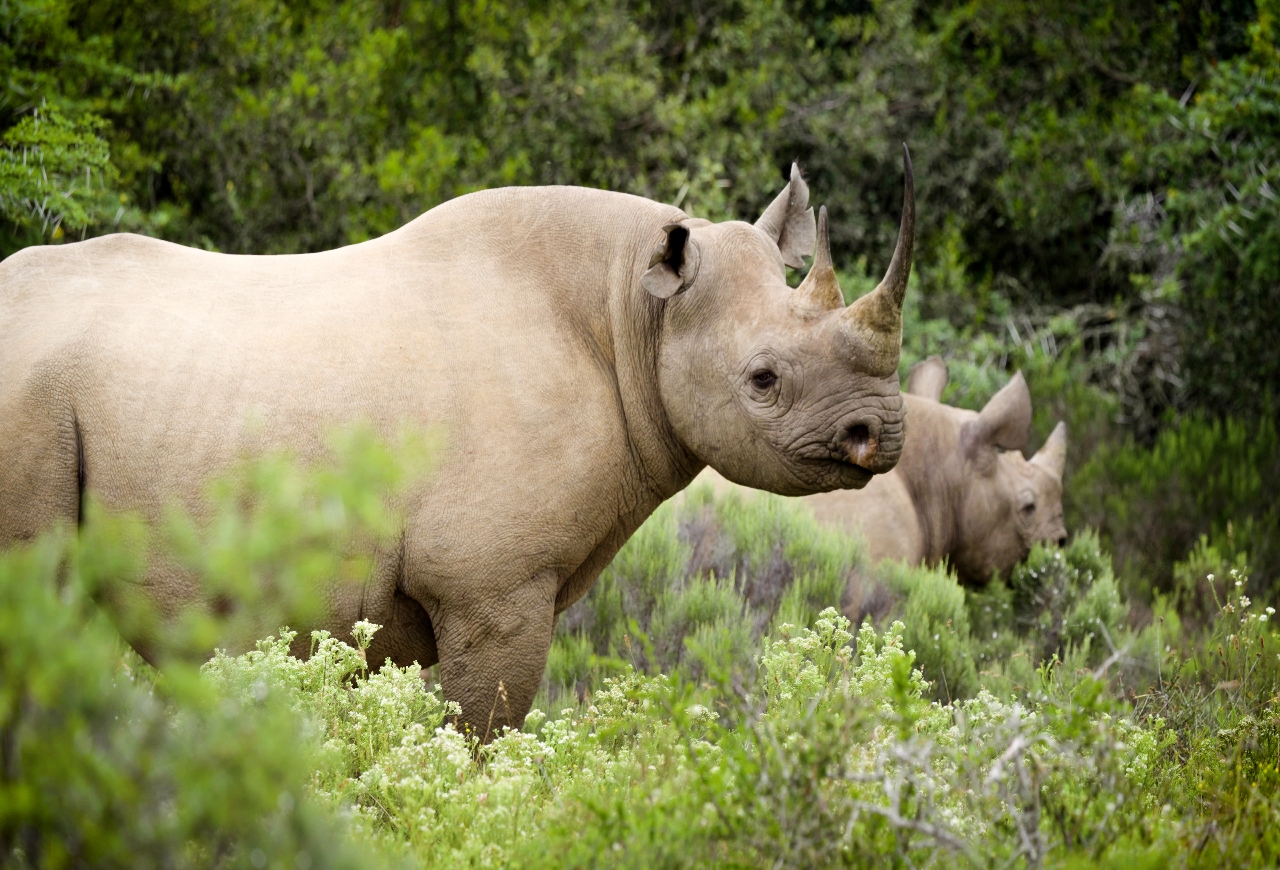To mark World Rhino Day on 22 September, Impact Investor spoke to the team behind the Wildlife Conservation Bond, working to help local black rhinoceros in South African populations recover from the brink of extinction.

Many people are familiar with the plight of black and white rhinoceros through the fundraising and awareness campaigns led by several notable wildlife charities over recent decades.
The black rhino, which is the focus of conservation efforts through the Wildlife Conservation Bond (WCB), issued by the World Bank, is the smaller of the two species.
According to the World Wildlife Fund, it saw its population drop by a dramatic 98% between 1960 and 1995, reaching less than 2,500 individuals. This decline has been driven mainly by habitat destruction and poaching. Although the black rhino has been brought back from the brink of extinction through tireless conservation efforts to more than 6000 individuals today, the species remains critically endangered.
Impact Investor spoke to the World Bank team behind the bond to learn more about how it all started and its success to date.
In March 2022, the World Bank issued the WCB off the back of the Rhino Impact Investment Project. The latter was a pilot project started by Zoological Society of London (ZSL) with the engagement of several stakeholders, including United for Wildlife, a partnership with six other wildlife charities and The Royal Foundation of the Duke and Duchess of Cambridge, to test innovative financing models that could help the recovery of rhino populations.
Nicknamed the Rhino Bond, the five-year WCB, which is due in March 2027, is said to be the first outcome-based bond dedicated to wildlife conservation. Elisson Wright, senior environmental finance specialist at the World Bank, explains: “This is an SDG-aligned bond and what is important, is that it is the first in which the coupon payments are made not to the investors but to two conservation parks.”
“What we didn’t want to do is make it so risky that only a very limited number of investors, such as philanthropies, would ever consider buying it,”
Michael Bennett
The $150m (€136m) bond works by investing the principal on a pooled basis to fund lending to sustainability programmes run by the World Bank worldwide. The coupon payments generated by the bond, which total R152m, worth approximately $10m at time of issuance, are then used to fund rhino conservation activities in two South African national parks.
When the bond reaches maturity, investors stand to receive conservation success payments, the value of which will depend on the growth rate of the black rhino populations in both parks. These will be made with funds provided by a performance-based grant from the Global Environment Facility (GEF), a multilateral environmental fund that invests into nature and climate change-related projects in the Global South and helped to finance the original pilot project.
“This is a very important way of mobilising a significant amount of investment for conservation in a rural part of South Africa without adding debt to the national government,” says Wright.

Explaining how the bond transferred project performance risk from donors such as the GEF to investors, he adds: “Investors are more attuned to taking risks and understanding the potential financial, environmental and social opportunities. For the South African WCB, investors have the opportunity to potentially earn a premium over a plain vanilla World Bank bond if rhino numbers increase to the highest targets set for the project.”
Investors in the bond include impact investors Nuveen and ASN Impact Investors as well as other institutional investors such as AllianceBernstein, Azimut Investments and Mackenzie Investments.
Outcome-oriented financing
Michael Bennett, head of market solutions and structured finance in the treasury department at the World Bank, who leads the treasury team responsible for issuing the WCB as well as other outcome bond products, says the Rhino Bond was also a response to rising demand from investors for a differentiated product.
“What we’re trying to do with the WCB is to respond to investors with a strong impact focus who want a direct link to a specific project,” he says, explaining that investors wanted to see the tangible difference their investment had made to specific outcomes.
“What the outcome bond product does is to offer investors additionality, in this case an increase in rhino numbers, which would otherwise not have occurred if they hadn’t bought the product,” he says.
Bennett says managing risk was also a key consideration in structuring the product.
“What we didn’t want to do is make it so risky that only a very limited number of investors, such as philanthropies, would ever consider buying it,” he says. He believes the WCB offers a structure that is safe enough that high grade fixed income investors would consider making an allocation.
This safety net is provided by the World Bank, which guarantees investors full repayment of their principal at maturity, irrespective of the rhino growth rate or project implementation risk.
“Our AAA principal is able to attract a much larger investor pool, with investments coming from investors’ foregone coupons made to two conservation parks with a strong track record in rhino conservation,” says Bennett.
What success looks like
The two parks targeted by the bond are the Great Fish River Nature Reserve (GFRNR) and the Addo Elephant National Park (AENP), both located in the Eastern Cape of South Africa.
If rhino populations across both parks increase by up to 2%, investors will receive $36.69 for every $1000 invested in the Rhino Bond. This rises to $73.38 for an increase of between 2% and 4% and $91.73 for growth rates above 4% to a maximum aggregated conservation success payment of $13.76m. If growth remains static or rhino populations fall, investors will not receive a success payment but will get their principal investment back.
“If the project meets the highest level of success we’ve set, the success payment will be about 50 basis points higher than the coupon investors gave up and make them more money than a vanilla World Bank bond,” says Bennett.
Two years into the project’s implementation, growth rates among the black rhino population of both parks, measured and verified by Conservation Alpha, a consultancy working in the field of conservation, and the ZSL, have exceeded expectations, with close to 8% growth recorded.
“This number takes into account removals in the population as well as introductions, to account for translocations of rhino into and aways from the parks,” explains Wright. “The GFRNR and the AENP are very important sites for the black rhino population in South Africa and the global population of black rhino and the WCB investments are making an additional and material impact.”
Financing gap
According to the World Bank, conservation of biodiversity and ecosystems faces an estimated annual financing gap of up to $700bn. A recent story in Impact Investor echoes these findings. The story covered a Phenix Capital Group report, which revealed a sharp increase in biodiversity-linked funds since 2015 but also highlighted the inadequacy of current financing levels targeting nature, which stand at $166bn (€155bn) per year. That figure would need to jump to $1trn by 2030 to sustainably manage biodiversity and maintain the integrity of ecosystems, according to the report.
The authors also highlighted the need for investor awareness of biodiversity’s interconnectedness to nearly all the SDGs. Rhino conservation is a case in point.
Rhinos are considered an umbrella species, meaning that efforts to protect them in the two parks targeted by the bond, which collectively represent a conservation area of 153,000 hectares, also protect other flora and fauna within their ecosystem. The AENP and the GFRNR also serve as carbon sinks and protect vital water catchment areas, and the AENP in particular, is valued for providing sanctuary for pollinators that serve roughly 25% of South Africa’s citrus industry.
Social impact
There are more direct social impacts to consider too.
By working to grow the black rhino population, the WCB set out to support over 2,000 beneficiaries in the local community. Bandita Sijapati, senior social development specialist at the World Bank, told Impact Investor that as of the second year of the project it had already supported 2,148 beneficiaries.
This figure, she explains, included both those directly employed through the project funding, such as park rangers, monitors, administrative staff and temporary workers, as well as local community members involved in existing programmes and activities at the parks that benefited from the investments.

“In the case of GFRNR, it has a co-management agreement with the local community and together they successfully comanage the reserve. Benefits from the WCB Project benefit the community as co-owner of the reserve,” she says. “In Addo, community initiatives have been ramped up since the start of the project and complement other programmes supported by the South African government.”
Sijapati says a key aim was to create stronger interfaces between the parks and local communities, both to reduce instrumental risks such as those from poachers but also to improve livelihoods by increasing realized benefits.
“Our aim here is two-fold, to raise awareness and involve local people in conservation efforts, but also to understand how the parks themselves can provide increased direct support to local people and the surrounding areas,” she adds.






